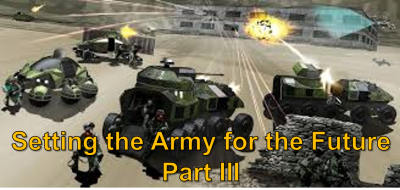[Editor’s Note: Mad Scientist Laboratory is pleased to publish the conclusion of our three-part series on setting the Army for the Future. In today’s post, we address specific actions TRADOC can take in converging the Institutional Army with the Operational Force to ensure that our Soldiers in the MDO Force of 2028 are prepared to both prevail in Competition and win decisively in Armed Conflict — Enjoy!]
A largely self-imposed, artificial barrier exists between the Institutional Army and the Operational Force. This organizational seam could become a hindrance to the transformation required to “Set the Army for the Future.” The Army should converge its Institutional Army and the Operational Force to ensure that we develop the requisite Future Ready Leader, provide immediate access to Army expertise without consideration to geolocation or current assignment, and more rapidly transfer knowledge throughout the force.
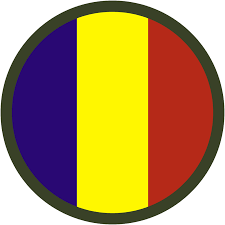 The effort to converge these two parts of the force requires a re-envisioning of Training and Doctrine Command (TRADOC) and its role in educating and providing initial entry training to the force. TRADOC cannot just be the place you go several times during a military career to prepare for the next level of responsibility. The Multi-Domain Operations (MDO) Force of 2028 will need immediate access to TRADOC’s resident expertise and TRADOC will need to rapidly learn from the experiences of the Operational Force, incorporating these lessons in on-going force-wide education and training experiences. This immediate access to specialized expertise and rapid incorporation of operational learning in force-wide training will be critical in competing with and, failing deterrence, during
The effort to converge these two parts of the force requires a re-envisioning of Training and Doctrine Command (TRADOC) and its role in educating and providing initial entry training to the force. TRADOC cannot just be the place you go several times during a military career to prepare for the next level of responsibility. The Multi-Domain Operations (MDO) Force of 2028 will need immediate access to TRADOC’s resident expertise and TRADOC will need to rapidly learn from the experiences of the Operational Force, incorporating these lessons in on-going force-wide education and training experiences. This immediate access to specialized expertise and rapid incorporation of operational learning in force-wide training will be critical in competing with and, failing deterrence, during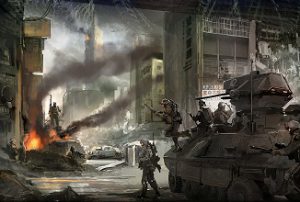 combat operations with a rapidly adapting adversary. Our experiences with the counter-IED fight — rapidly learning and adapting tactical defensive and offensive capabilities — was not a one-off but a weak signal of what future conflict will look like.
combat operations with a rapidly adapting adversary. Our experiences with the counter-IED fight — rapidly learning and adapting tactical defensive and offensive capabilities — was not a one-off but a weak signal of what future conflict will look like.
To set the Army and TRADOC for this future, here are a few ideas:
1) Envision a TRADOC with fewer bricks and more clicks. The world is moving from the physical to the digital/virtual. A similar transformation to move TRADOC to a more digital/virtual learning platform will require a shift in  investment priorities to connectivity (maybe a near term/mid-term move to 5G) and a data strategy that connects our silos of data into one architecture improving content and future AI integration.
investment priorities to connectivity (maybe a near term/mid-term move to 5G) and a data strategy that connects our silos of data into one architecture improving content and future AI integration.
2) Remove a few rocks and put “TRADOC in your ruck.” Personal Artificial Intelligence (AI) assistants could bring Commanders and their staffs all of the collected expertise of today’s Institutional Force. Conducting machine speed collection,  collation, and analysis of battlefield information will free up warfighters and commanders to do what they do best — fight and make decisions, respectively. AI’s ability to quickly sift through and analyze the plethora of input received from across the battlefield, fused with the lessons learned data from thousands of previous engagements, will lessen the commander’s dependence on having had direct personal combat experience with conditions similar to his current fight when making command decisions.
collation, and analysis of battlefield information will free up warfighters and commanders to do what they do best — fight and make decisions, respectively. AI’s ability to quickly sift through and analyze the plethora of input received from across the battlefield, fused with the lessons learned data from thousands of previous engagements, will lessen the commander’s dependence on having had direct personal combat experience with conditions similar to his current fight when making command decisions.
3) Start learning in our formations like we learn at home. If you have a plumbing problem at home, it is a fair bet that you will turn to YouTube to learn the best techniques for fixing your problem. This technique of crowdsourcing expertise and allowing the herd to select best methods enables the rapid 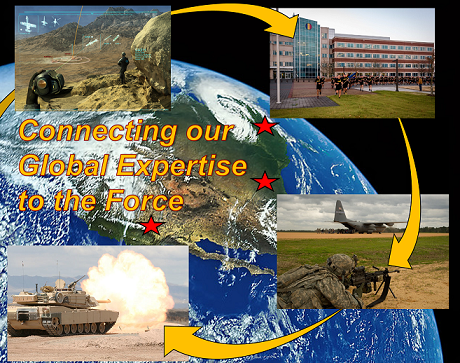 transfer of knowledge, and geolocation is not important. We have a globally engaged Army and we need to connect our global expertise to the force. Today the best squad leaders from the Combat Training Centers (CTCs) should be able to share their experiences and have videos of their actions shareable across a learning platform available to all NCOs, at any location. The best fuel handlers in the Army should be able to share their Tactics, Techniques, and Procedures (TTPs) in near real time. Sharing content and interacting with expertise is how Millennial and Gen Z Soldiers learn at home. We need to bring these ideas to how we develop them in their formations.
transfer of knowledge, and geolocation is not important. We have a globally engaged Army and we need to connect our global expertise to the force. Today the best squad leaders from the Combat Training Centers (CTCs) should be able to share their experiences and have videos of their actions shareable across a learning platform available to all NCOs, at any location. The best fuel handlers in the Army should be able to share their Tactics, Techniques, and Procedures (TTPs) in near real time. Sharing content and interacting with expertise is how Millennial and Gen Z Soldiers learn at home. We need to bring these ideas to how we develop them in their formations.
4) Bring recent training and operational data to the classroom. A more virtual TRADOC does not mean an end to classrooms, but can the MDO Force of 2028 get by with the Professional Military Education (PME) of today? Gamification and simulation in the classroom must become the norm. TRADOC has explored capabilities like virtual tutors, living doctrine, and knowledge delivery, but the effort requires  resources and a strategy for implementation. A start point should be a data strategy that makes available to our Leaders the curated lessons learned data at the Center for Army Lessons Learned with the training data sets at our CTCs. The Army is a data rich organization with information from previous training events, combat operations, and readiness status; but data rich does not mean data ready. Much of the Army’s data could be characterized as “dark data,” sitting in a silo ready for single-use purposes. The Captain of 2028 should have gaming and micro-simulation tools to experiment with tactics and learn what worked and what did not in ongoing real world operations and at our ongoing CTC rotations.
resources and a strategy for implementation. A start point should be a data strategy that makes available to our Leaders the curated lessons learned data at the Center for Army Lessons Learned with the training data sets at our CTCs. The Army is a data rich organization with information from previous training events, combat operations, and readiness status; but data rich does not mean data ready. Much of the Army’s data could be characterized as “dark data,” sitting in a silo ready for single-use purposes. The Captain of 2028 should have gaming and micro-simulation tools to experiment with tactics and learn what worked and what did not in ongoing real world operations and at our ongoing CTC rotations.
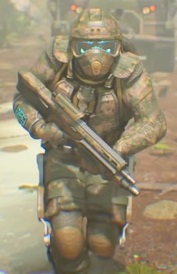 Converging the Institutional Army and the Operational Force is a complex endeavor, but it is clear that increasing connectivity, transitioning from physical to digital/virtual infrastructures, and making the Army’s wealth of data accessible will provide the MDO Force of 2028 with advantages over our adversaries during Competition and Conflict. We just need to re-envision our Army and connect our greatest resource, the Soldier.
Converging the Institutional Army and the Operational Force is a complex endeavor, but it is clear that increasing connectivity, transitioning from physical to digital/virtual infrastructures, and making the Army’s wealth of data accessible will provide the MDO Force of 2028 with advantages over our adversaries during Competition and Conflict. We just need to re-envision our Army and connect our greatest resource, the Soldier.
I hope you have enjoyed the series, “Setting the Army for the Future.” What are your ideas? Feel free to use our current crowdsourcing writing contest as a forum to share.
If you enjoyed this post, please read:
– Setting the Army for the Future (Part I) by Mr. Gary Phillips, and Part II
– The Mad Scientist Learning in 2050 Conference Final Report

